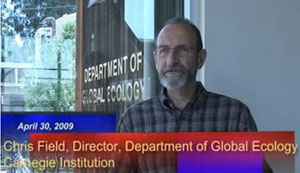 Bioelectricity Promises More ‘Miles Per Acre’ Than EthanolMay 7, 2009 - Carnegie Institution for Science
"It's a relatively obvious question once you ask it, but nobody had really asked it before," says study co-author Chris Field, director of the Department of Global Ecology at the Carnegie Institution. "The kinds of motivations that have driven people to think about developing ethanol as a vehicle fuel have been somewhat different from those that have been motivating people to think about battery electric vehicles, but the overlap is in the area of maximizing efficiency and minimizing adverse impacts on climate." Field, who is also a professor of biology at Stanford University and a senior fellow at Stanford's Woods Institute for the Environment, is part of a research team that includes lead author Elliott Campbell of the University of California, Merced, and David Lobell of Stanford's Program on Food Security and the Environment. The researchers performed a life-cycle analysis of both bioelectricity and ethanol technologies, taking into account not only the energy produced by each technology, but also the energy consumed in producing the vehicles and fuels. For the analysis, they used publicly available data on vehicle efficiencies from the US Environmental Protection Agency and other organizations. Bioelectricity was the clear winner in the transportation-miles-per-acre comparison, regardless of whether the energy was produced from corn or from switchgrass, a cellulose-based energy crop. For example, a small SUV powered by bioelectricity could travel nearly 14,000 highway miles on the net energy produced from an acre of switchgrass, while a comparable internal combustion vehicle could only travel about 9,000 miles on the highway. (Average mileage for both city and highway driving would be 15,000 miles for a biolelectric SUV and 8,000 miles for an internal combustion vehicle.) "The internal combustion engine just isn't very efficient, especially when compared to electric vehicles," says Campbell. "Even the best ethanol-producing technologies with hybrid vehicles aren't enough to overcome this." The researchers found that bioelectricity and ethanol also differed in their potential impact on climate change. "Some approaches to bioenergy can make climate change worse, but other limited approaches can help fight climate change," says Campbell. "For these beneficial approaches, we could do more to fight climate change by making electricity than making ethanol." The energy from an acre of switchgrass used to power an electric vehicle would prevent or offset the release of up to 10 tons of CO2 per acre, relative to a similar-sized gasoline-powered car. Across vehicle types and different crops, this offset averages more than 100% larger for the bioelectricity than for the ethanol pathway. Bioelectricity also offers more possibilities for reducing greenhouse gas emissions through measures such as carbon capture and sequestration, which could be implemented at biomass power stations but not individual internal combustion vehicles. While the results of the study clearly favor bioelectricity over ethanol, the researchers caution that the issues facing society in choosing an energy strategy are complex. "We found that converting biomass to electricity rather than ethanol makes the most sense for two policy-relevant issues: transportation and climate," says Lobell. "But we also need to compare these options for other issues like water consumption, air pollution, and economic costs." "There is a big strategic decision our country and others are making: whether to encourage development of vehicles that run on ethanol or electricity," says Campbell. "Studies like ours could be used to ensure that the alternative energy pathways we chose will provide the most transportation energy and the least climate change impacts." ### This research was funded through a grant from the Stanford University Global Climate and Energy Project, with additional support from the Stanford University Food Security and Environment Project, The University of California at Merced, the Carnegie Institution for Science, and a NASA New Investigator Grant. # # # View the graphic here (Credit: McDade & Campbell/UC Merced) |
[an error occurred while processing this directive][an error occurred while processing this directive] [an error occurred while processing this directive][an error occurred while processing this directive]
 STANFORD,
CA - Biofuels such as ethanol offer an alternative
to petroleum for powering our cars, but growing
energy crops to produce them can compete with food
crops for farmland, and clearing forests to expand
farmland will aggravate the climate change problem.
How can we maximize our "miles per acre" from biomass?
Researchers writing in the online edition of the
May 7 Science magazine say the best bet is to convert
the biomass to electricity, rather than ethanol.
They calculate that, compared to ethanol used for
internal combustion engines, bioelectricity used
for battery-powered vehicles would deliver an average
of 80% more miles of transportation per acre of
crops, while also providing double the greenhouse
gas offsets to mitigate climate change.
STANFORD,
CA - Biofuels such as ethanol offer an alternative
to petroleum for powering our cars, but growing
energy crops to produce them can compete with food
crops for farmland, and clearing forests to expand
farmland will aggravate the climate change problem.
How can we maximize our "miles per acre" from biomass?
Researchers writing in the online edition of the
May 7 Science magazine say the best bet is to convert
the biomass to electricity, rather than ethanol.
They calculate that, compared to ethanol used for
internal combustion engines, bioelectricity used
for battery-powered vehicles would deliver an average
of 80% more miles of transportation per acre of
crops, while also providing double the greenhouse
gas offsets to mitigate climate change.